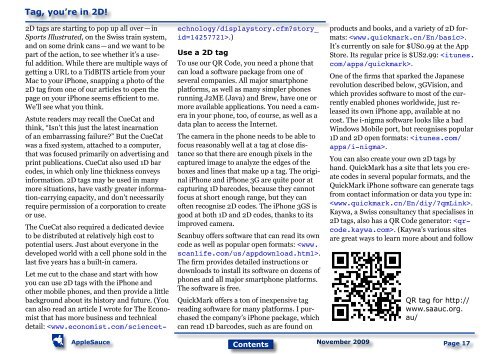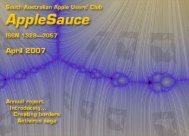AppleSauce, December 2009 - South Australian Apple Users' Club
AppleSauce, December 2009 - South Australian Apple Users' Club
AppleSauce, December 2009 - South Australian Apple Users' Club
You also want an ePaper? Increase the reach of your titles
YUMPU automatically turns print PDFs into web optimized ePapers that Google loves.
Tag, you’re in 2D!<br />
2D tags are starting to pop up all over — in<br />
Sports Illustrated, on the Swiss train system,<br />
and on some drink cans — and we want to be<br />
part of the action, to see whether it’s a useful<br />
addition. While there are multiple ways of<br />
getting a URL to a TidBITS article from your<br />
Mac to your iPhone, snapping a photo of the<br />
2D tag from one of our articles to open the<br />
page on your iPhone seems efficient to me.<br />
We’ll see what you think.<br />
Astute readers may recall the CueCat and<br />
think, “Isn’t this just the latest incarnation<br />
of an embarrassing failure?” But the CueCat<br />
was a fixed system, attached to a computer,<br />
that was focused primarily on advertising and<br />
print publications. CueCat also used 1D bar<br />
codes, in which only line thickness conveys<br />
information. 2D tags may be used in many<br />
more situations, have vastly greater information-carrying<br />
capacity, and don’t necessarily<br />
require permission of a corporation to create<br />
or use.<br />
The CueCat also required a dedicated device<br />
to be distributed at relatively high cost to<br />
potential users. Just about everyone in the<br />
developed world with a cell phone sold in the<br />
last five years has a built-in camera.<br />
Let me cut to the chase and start with how<br />
you can use 2D tags with the iPhone and<br />
other mobile phones, and then provide a little<br />
background about its history and future. (You<br />
can also read an article I wrote for The Economist<br />
that has more business and technical<br />
detail: .)<br />
Use a 2D tag<br />
To use our QR Code, you need a phone that<br />
can load a software package from one of<br />
several companies. All major smartphone<br />
platforms, as well as many simpler phones<br />
running J2ME (Java) and Brew, have one or<br />
more available applications. You need a camera<br />
in your phone, too, of course, as well as a<br />
data plan to access the Internet.<br />
The camera in the phone needs to be able to<br />
focus reasonably well at a tag at close distance<br />
so that there are enough pixels in the<br />
captured image to analyze the edges of the<br />
boxes and lines that make up a tag. The original<br />
iPhone and iPhone 3G are quite poor at<br />
capturing 1D barcodes, because they cannot<br />
focus at short enough range, but they can<br />
often recognise 2D codes. The iPhone 3GS is<br />
good at both 1D and 2D codes, thanks to its<br />
improved camera.<br />
Scanbuy offers software that can read its own<br />
code as well as popular open formats: .<br />
The firm provides detailed instructions or<br />
downloads to install its software on dozens of<br />
phones and all major smartphone platforms.<br />
The software is free.<br />
QuickMark offers a ton of inexpensive tag<br />
reading software for many platforms. I purchased<br />
the company’s iPhone package, which<br />
can read 1D barcodes, such as are found on<br />
products and books, and a variety of 2D formats:<br />
.<br />
It’s currently on sale for $US0.99 at the App<br />
Store. Its regular price is $US2.99: .<br />
One of the firms that sparked the Japanese<br />
revolution described below, 3GVision, and<br />
which provides software to most of the currently<br />
enabled phones worldwide, just released<br />
its own iPhone app, available at no<br />
cost. The i-nigma software looks like a bad<br />
Windows Mobile port, but recognises popular<br />
1D and 2D open formats: .<br />
You can also create your own 2D tags by<br />
hand. QuickMark has a site that lets you create<br />
codes in several popular formats, and the<br />
QuickMark iPhone software can generate tags<br />
from contact information or data you type in:<br />
.<br />
Kaywa, a Swiss consultancy that specialises in<br />
2D tags, also has a QR Code generator: .<br />
(Kaywa’s various sites<br />
are great ways to learn more about and follow<br />
QR tag for http://<br />
www.saauc.org.<br />
au/<br />
November <strong>2009</strong><br />
<strong><strong>Apple</strong>Sauce</strong> Page 17<br />
Contents






